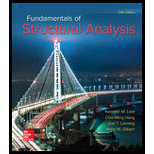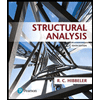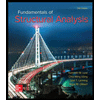
Concept explainers
(a)
Categorize the given truss is stable or unstable.
Verify the truss is determinate or indeterminate in case the truss is stable.
Find the degree of indeterminacy in case the given truss is statically indeterminate.
(a)
Answer to Problem 1P
The plane truss is stable.
The plane truss is statically indeterminate.
The plane truss is indeterminate with indeterminacy of 2.
Explanation of Solution
Use the equations to find the stability of the truss.
Here, the b is the number of bars and n is the joints.
Show the conditions for static instability, determinacy, and indeterminacy of the plane truss as follows:
Here, r is the support reactions.
Show the expression for the degree of static indeterminacy (i) as follows:
Refer the Figure of the given plane truss.
The number of the bars in the plane truss is
The number of reaction is
The number of the joints in the plane truss is
Substitute the values of b, r, and n with Equation (2).
Thus, the plane truss is stable.
Substitute the values of b, r, and n with Equation (5).
Thus, the plane truss is statically indeterminate.
Find the degree of static indeterminacy of the truss as follows:
Substitute the values of b, r, and n with Equation (6).
Thus, the plane truss is indeterminate with indeterminacy of 2.
(b)
Categorize the given truss is stable or unstable.
Verify the truss is determinate or indeterminate in case the truss is stable.
Find the degree of indeterminacy in case the given truss is statically indeterminate.
(b)
Answer to Problem 1P
The plane truss is stable.
The plane truss is statically indeterminate.
The plane truss is indeterminate with indeterminacy of 2.
Explanation of Solution
Refer the Figure of the given plane truss.
The number of the bars in the plane truss is
The number of reaction is
The number of the joints in the plane truss is
Substitute the values of b, r, and n with Equation (2).
Thus, the plane truss is stable.
Substitute the values of b, r, and n with Equation (5).
Thus, the plane truss is statically indeterminate.
Find the degree of static indeterminacy of the truss as follows:
Substitute the values of b, r, and n with Equation (6).
Thus, the plane truss is indeterminate with indeterminacy of 2.
(c)
Categorize the given truss is stable or unstable.
Verify the truss is determinate or indeterminate in case the truss is stable.
Find the degree of indeterminacy in case the given truss is statically indeterminate.
(c)
Answer to Problem 1P
The plane truss is geometrically unstable.
Explanation of Solution
Refer the Figure of the given plane truss.
The number of the bars in the plane truss is
The number of reaction is
The number of the joints in the plane truss is
Substitute the values of b, r, and n with Equation (1).
Thus, the plane truss is geometrically unstable.
(d)
Categorize the given truss is stable or unstable.
Verify the truss is determinate or indeterminate in case the truss is stable.
Find the degree of indeterminacy in case the given truss is statically indeterminate.
(d)
Answer to Problem 1P
The plane truss is stable.
The plane truss is statically indeterminate.
The plane truss is indeterminate with indeterminacy of 2.
Explanation of Solution
Refer the Figure of the given plane truss.
The number of the bars in the plane truss is
The number of reaction is
The number of the joints in the plane truss is
Substitute the values of b, r, and n with Equation (2).
Thus, the plane truss is stable.
Substitute the values of b, r, and n with Equation (5).
Thus, the plane truss is statically indeterminate.
Find the degree of static indeterminacy of the truss as follows:
Substitute the values of b, r, and n with Equation (6).
Thus, the plane truss is indeterminate with indeterminacy of 2.
(e)
Categorize the given truss is stable or unstable.
Verify the truss is determinate or indeterminate in case the truss is stable.
Find the degree of indeterminacy in case the given truss is statically indeterminate.
(e)
Answer to Problem 1P
The plane truss is geometrically unstable.
Explanation of Solution
Refer the Figure of the given plane truss.
The number of the bars in the plane truss is
The number of reaction is
The number of the joints in the plane truss is
Substitute the values of b, r, and n with Equation (1).
Thus, the plane truss is geometrically unstable.
(f)
Categorize the given truss is stable or unstable.
Verify the truss is determinate or indeterminate in case the truss is stable.
Find the degree of indeterminacy in case the given truss is statically indeterminate.
(f)
Answer to Problem 1P
The plane truss is stable and determinate.
Explanation of Solution
Refer the Figure of the given plane truss.
The number of the bars in the plane truss is
The number of reaction is
The number of the joints in the plane truss is
Substitute the values of b, r, and n with Equation (4).
Thus, the plane truss is stable and determinate.
(g)
Categorize the given truss is stable or unstable.
Verify the truss is determinate or indeterminate in case the truss is stable.
Find the degree of indeterminacy in case the given truss is statically indeterminate.
(g)
Answer to Problem 1P
The plane truss is stable and determinate.
Explanation of Solution
Refer the Figure of the given plane truss.
The number of the bars in the plane truss is
The number of reaction is
The number of the joints in the plane truss is
Substitute the values of b, r, and n with Equation (4).
Thus, the plane truss is stable and determinate.
(h)
Categorize the given truss is stable or unstable.
Verify the truss is determinate or indeterminate in case the truss is stable.
Find the degree of indeterminacy in case the given truss is statically indeterminate.
(h)
Answer to Problem 1P
The plane truss is geometrically unstable.
Explanation of Solution
Refer the Figure of the given plane truss.
The number of the bars in the plane truss is
The number of reaction is
The number of the joints in the plane truss is
The reactions are concurrent.
Refer to the given figure, all the supports are roller. So the structure is geometrically unstable.
Thus, the plane truss is geometrically unstable.
Want to see more full solutions like this?
Chapter 4 Solutions
Fundamentals of Structural Analysis
- I want an answer very quickly, pleasearrow_forwardI want an answer very quickly, pleasearrow_forwardQ1/ Choose the correct answer for the following: 1- Cantilever retaining walls is suitable for retaining backfill about a- 8m d-4m b- 12m c- 2m e- Any height 2-The shear key is provided to a- Avoid friction behind the wall d- All of the above b- Improve appearance e- None of the above c- Increase passive resistance types of retaining wall may b- Semi-gravity retaining walls d-Counterfort retaining walls be classified as follows: 3- The common a- Gravity retaining walls walls c- Cantilever retaining e- All the mentioned 4-Related to Stability of RW, Which of the following does not represent a potential failure mode for a retaining wall? a-Bearing capacity failure of the foundation soil. b- Wall cracking due to thermal expansion. c- Excessive settlement due to weak soil layer. d- Shear failure within the foundation soil adjacent to the wall. e-Sliding along the base due to insufficient friction. 5- If the desired factor of safety against sliding is not met, which strategy is NOT a…arrow_forward
- For the truss shown in Fig 2, determine the nodal displacement and member forces using the stifness method for all elements of the truss. Assume for each member A = 0.0015 m2 and E = 200 GPa please show all workingarrow_forwardTwo W14x38 tension members are connected with a splice connection using plates attached atthe top and the bottom flanges. The design axial load Pu is 320 kips. The bolts are made of A325X, and thebolt diameter is ½ inch. (Slip-Critical connection)( LRFD units)( Previous Solution was incomplete/incorrect)arrow_forwardA tension member made of L4x4x1/2 is connected to gusset plate with welds. Using E70electrode and ½ inch weld size, design the balanced weld lengths.( Use AISC manual, LRFD units)(Previous solution was incorrect)arrow_forward
- Two W14x38 tension members are connected with a splice connection using plates attached atthe top and the bottom flanges. The design axial load Pu is 320 kips. The bolts are made of A325X, and thebolt diameter is ½ inch. (Slip-Critical connection)( LRFD units)arrow_forwardA tension member made of L4x4x1/2 is connected to gusset plate with welds. Using E70electrode and ½ inch weld size, design the balanced weld lengths.( Use AISC manual, LRFD units)arrow_forward= A steel pile (H-section; HP 310 x 125; and so A, 15.9 x 10-3 m² ) is driven into a layer of sandstone. The length of the pile is 25 m. Following are the properties of the sandstone: unconfined compression strength = qu(lab) = 78 MN/m² and angle of friction = 36°. Using a factor of safety of 3, estimate the allowable point load that can be carried by the pile. Use [qu(d Qu(lab). qu(design) b)/5]. (Enter your answer to three significant figures.) Qp(all) kNarrow_forward

 Structural Analysis (10th Edition)Civil EngineeringISBN:9780134610672Author:Russell C. HibbelerPublisher:PEARSON
Structural Analysis (10th Edition)Civil EngineeringISBN:9780134610672Author:Russell C. HibbelerPublisher:PEARSON Principles of Foundation Engineering (MindTap Cou...Civil EngineeringISBN:9781337705028Author:Braja M. Das, Nagaratnam SivakuganPublisher:Cengage Learning
Principles of Foundation Engineering (MindTap Cou...Civil EngineeringISBN:9781337705028Author:Braja M. Das, Nagaratnam SivakuganPublisher:Cengage Learning Fundamentals of Structural AnalysisCivil EngineeringISBN:9780073398006Author:Kenneth M. Leet Emeritus, Chia-Ming Uang, Joel LanningPublisher:McGraw-Hill Education
Fundamentals of Structural AnalysisCivil EngineeringISBN:9780073398006Author:Kenneth M. Leet Emeritus, Chia-Ming Uang, Joel LanningPublisher:McGraw-Hill Education
 Traffic and Highway EngineeringCivil EngineeringISBN:9781305156241Author:Garber, Nicholas J.Publisher:Cengage Learning
Traffic and Highway EngineeringCivil EngineeringISBN:9781305156241Author:Garber, Nicholas J.Publisher:Cengage Learning





